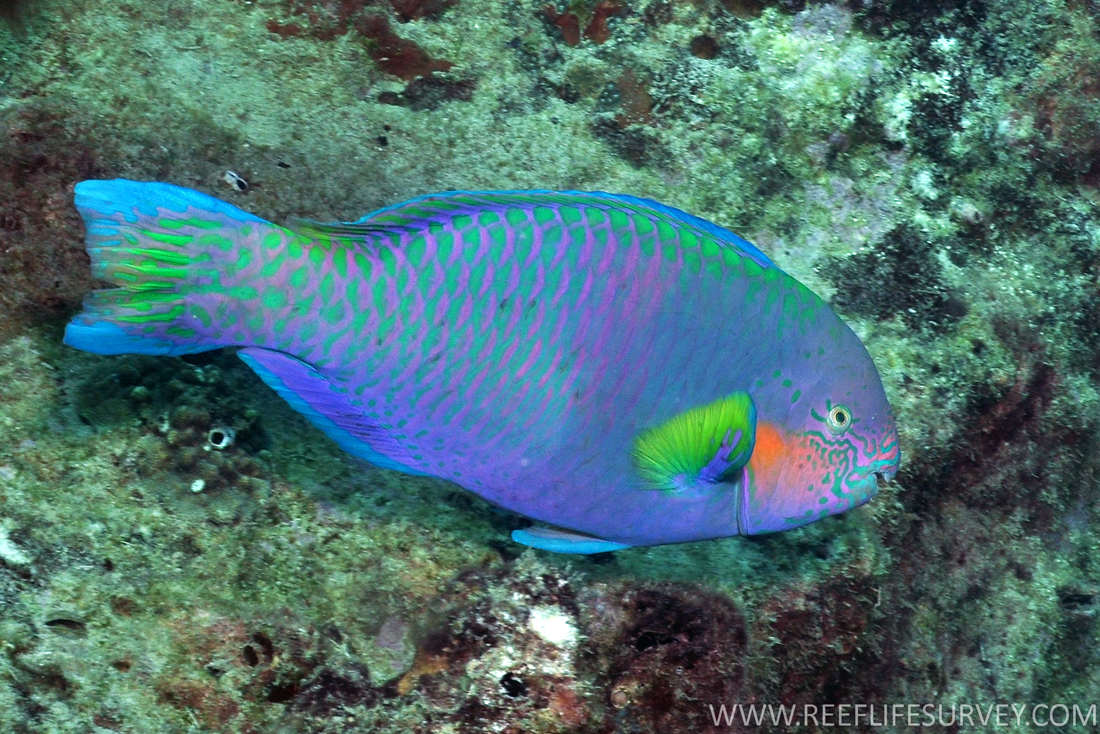- Classification
- ACTINOPTERYGII
- PERCIFORMES
- LABRIDAE
- Scarus
- rivulatus
Surf Parrotfish, Scarus rivulatus Valenciennes 1840
Other Names: Rivulated Parrotfish, Scribblefaced Parrotfish

A Surf Parrotfish, Scarus rivulatus, at Mornington Island, Queensland. Source: Rick Stuart-Smith / Reef Life Survey. License: CC by Attribution
Summary:
Males can be easily recognised by the orange patch on the cheek and gill cover, orange wavy lines and bands on the snout and cheek, and pale green pectoral fins. Females (Initial Phase) are grey to greyish-brown or lilac-greyish with two pales stripes along the belly.
Cite this page as:
Dianne J. Bray, Scarus rivulatus in Fishes of Australia, accessed 06 Jul 2025, https://fishesofaustralia.net.au/Home/species/931
Surf Parrotfish, Scarus rivulatus Valenciennes 1840
More Info
|
Distribution |
Rottnest Island, Western Australia, to Moreton Bay, Queensland; also reefs in the Coral Sea, and the Lord Howe Island region and Norfolk Island in the Tasman Sea. Elsewhere, the species occurs in the tropical, west Pacific (including the Kermadec Islands). Inhabits coastal reefs and offshore reefs, inclucing tidepools and silty areas - often forming large schools. |
|
Features |
Dorsal fin IX, 10; Anal fin III, 9; Pectoral fin 13-15; Median predorsal scales 5-7; scale rows on cheek 3 (2-4 scales in lower row). |
|
Colour |
Males can be recognised by their orange cheeks and yellow pectoral fins. Females are plain grey with two pale lines along the belly. |
|
Biology |
Scarus rivulatus is a protogynous hermaphrodite, and individuals change sex from female to male during their life cycle. |
|
Similar Species |
Initial phase individuals closely resemble those of Scarus globiceps and S. psittacus, and differ in the number of scale rows and scales in the underside side. |
|
Species Citation |
Scarus rivulatus Valenciennes, A. in Cuvier, G.L. & Valenciennes, A. 1840. Histoire Naturelle des Poissons. Paris : Levrault Vol. 14 464 pp. pls 389-420. [223].Type data: Holotype MNHP 1738, Java. |
|
Author |
Dianne J. Bray |
|
Resources |
Surf Parrotfish, Scarus rivulatus Valenciennes 1840
References
Allen, G.R. & Erdmann, M.V. 2012. Reef fishes of the East Indies. Perth : Tropical Reef Research 3 vols, 1260 pp.
Alleyne, H.G. & Macleay, W.J. 1877. The ichthyology of the Chevert Expedition. Proceedings of the Linnean Society of New South Wales 1(3–4): 261-281, 321-359, pls 3-9, 10-17 (described as Pseudoscarus flavolineatus)
Bellwood, D.R. 1994. A phylogenetic study of the parrotfishes Family Scaridae (Pisces: Labroidei), with a revision of genera. Records of the Australian Museum Supplement 20: 1-86. PDF Open access
Bellwood, D.R. & Choat, J.H. 1989. A description of the juvenile phase colour patterns of 24 parrotfish species (family Scaridae) from the Great Barrier Reef, Australia. Records of the Australian Museum 41(1): 1–41. PDF Open access
Bellwood, D.R. & J.H. Choat. 1990. A functional analysis of grazing in parrotfishes (family Scaridae): the ecological implications. Environ. Biol. Fish. 28: 189-214.
Choat, J.H., Axe, L.M. & Lou, D.C. 1996. Growth and longevity in fishes of the family Scaridae. Marine Ecology Progress Series 145: 33-41.
Choat, J.H. & Randall, J.E. 1986. A review of the parrotfishes (Family Scaridae) of the Great Barrier Reef of Australia with description of a new species. Records of the Australian Museum 38: 175-228. PDF Open access
Choat, J.H. & D.R. Robertson. 1975. Protogynous hermaphroditism in fishes of the family Scaridae. P. 263-283, in R. Reinboth (ed.) Intersexuality in the animal kingdom. Springer, Heidelberg.
Comeros-Raynal, M.T., Choat, J.H., Polidoro, B.A., Clements, K.D., Abesamis, R., Craig, M.T., Lazuardi, M.E., McIlwain, J., Muljadi, A., Myers, R.F., Nañola Jr., C.L., Pardede, S., Rocha, L.A., Russell, B.C., Sanciangco, J.C., Stockwell, B., Harwell, H. & Carpenter, K.E. 2012. The likelihood of extinction of iconic and dominant components of coral reefs: the parrotfishes and surgeonfishes. PLoS ONE http://dx.plos.org/10.1371/journal.pone.0039825.
Francis, M.P. 1993. Checklist of the coastal fishes of Lord Howe, Norfolk, and Kermadec Islands, Southwest Pacific Ocean. Pacific Science 47(2): 136-170.
Larson, H.K., Williams, R.S. & Hammer, M.P. 2013. An annotated checklist of the fishes of the Northern Territory, Australia. Zootaxa 3696(1): 1-293.
Myers, R., Choat, J.H., Russell, B., Clements, K.D., Rocha, L.A., Muljadi, A., Lazuardi, M.E., Pardede, S. & Rahardjo, P. 2012. Scarus rivulatus. The IUCN Red List of Threatened Species 2012: e.T190717A17794751. http://dx.doi.org/10.2305/IUCN.UK.2012.RLTS.T190717A17794751.en. Downloaded on 15 March 2016.
Randall, J.E., Allen, G.R. & Steene, R. 1997. Fishes of the Great Barrier Reef and Coral Sea. Bathurst : Crawford House Press 557 pp. figs.
Randall, J.E. & Choat, J.H. 1980. Two new parrotfishes of the genus Scarus from the Central and South Pacific, with further examples of sexual dichromatism. Journal of the Linnean Society of London 70: 383-419.
Smith, L.L., Fessler, J.L., Alfaro, M.E., Streelman, J.T. & Westneat, M.W. 2008. Phylogenetic relationships and the evolution of regulatory gene sequences in the parrotfishes. Molecular Phylogenetics and Evolution 49: 136-152.
Valenciennes, A. 1840, in Cuvier, G.L. & Valenciennes, A. Histoire Naturelle des Poissons. Paris : Levrault Vol. 14 464 pp. pls 389-420.
Westneat, M.W. & Alfaro, M.E. 2005. Phylogenetic relationships and evolutionary history of the reef fish family Labridae. Molecular Phylogenetics and Evolution 36: 370–390.








